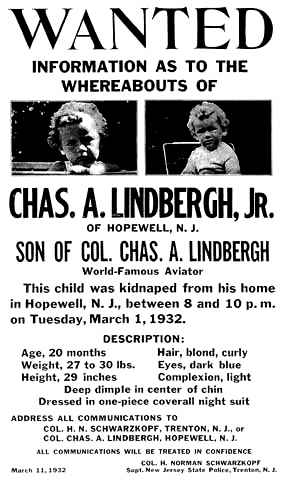 The remains of little Charles Lindbergh Jr., son of pioneering aviator hero Charles Lindbergh and writer Anne Morrow Lindbergh, were discovered on May 12, 1932, over two months after the toddler had been snatched from his family’s mansion in Hopewell, N.J.
The remains of little Charles Lindbergh Jr., son of pioneering aviator hero Charles Lindbergh and writer Anne Morrow Lindbergh, were discovered on May 12, 1932, over two months after the toddler had been snatched from his family’s mansion in Hopewell, N.J.
On the night of March 1, 1932, baby Charlie’s nurse went to check on him around 10 p.m. and made the horrific discovery that the child was gone. Charles Lindbergh rushed into his son’s room to see two heart-breaking, ominous sights – an empty crib and an envelope. The envelope contained a poorly written ransom note that read:
Dear Sir,
Have 50,000$ redy 25000$ in 20$ bills 15000$ in 10$ bills and 10000$ in 5$ bills. After 2-4 days will inform you were to deliver the Mony. We warn you for making anyding public or for notify the Polise the child is in gut care. Indication for all letters are singnature and 3 holds.
Within 30 minutes, every news outlet was announcing the story and sightings of the baby came pouring in, none of which panned out.
The New Jersey State Police officially took over the investigation, but Colonel H. Norman Schwarzkopf (father of the Gulf War’s Stormin’ Norman), who was officially in charge, allowed Lindbergh to run the show.
Lucky Lindy may have known scads about aviation, but a kidnapping investigation was a little over his head. Important evidence was essentially ruined – footprints trampled, evidence handled by numerous people – which seriously hurt the chances of apprehending the perpetrator.
A new ransom letter appeared three days later demanding $70,000, but when the money was delivered, baby Charlie was not at the promised location. The heartbroken Lindberghs had been lied to.
On May 12, 1932, the partially buried and badly decomposed tiny body of Charles Lindbergh, Jr. was discovered by truck driver William Allen. The little guy was found in Mount Rose, New Jersey, about four miles from his home.
An autopsy showed that death was caused by a blow to the head, and that the child had been dead for over two months, probably since the night he was kidnapped. His father positively identified him, and the remains were cremated in Trenton, New Jersey on May 13. The Lindberghs donated their Hopewell home to charity and moved from the house where they lived every parent’s worst nightmare.
It appeared that the Lindbergh baby’s death would be relegated to the unsolved murder files until a marked bill from the ransom happened to pop up in September 1934. A gas station attendant found the man who passed him one of the bills suspicious, and he jotted down and reported his license plate number.
The car belonged to a German-born carpenter named Bruno Hauptmann. When authorities searched his home, they uncovered $13,000 of marked Lindbergh ransom money. Hauptmann claimed the money belonged to a friend who had since died. The cops weren’t buying it, and in January 1935, the “Trial of the Century” began when Bruno Hauptmann was tried for the kidnapping and murder of Charles Lindbergh, Jr.
Hauptmann strongly proclaimed his innocence. He also claimed he was beaten by the police and coerced into changing his handwriting so it matched that of the ransom notes. The only strong evidence of guilt the state had was the marked ransom money, but it was more than enough to win a conviction.
Bruno Richard Hauptmann was found guilty of kidnapping and first degree murder and was sentenced to die in the electric chair. He was executed on April 3, 1936. Many had doubts about Hauptmann’s guilt, including the governor of New Jersey, but all appeals were ultimately unsuccessful. In the aftermath of the Lindbergh baby tragedy, kidnapping was made a federal crime.
If you liked this article, you might also enjoy:
- The Tragic Family Life of Kelsey Grammer
- Why Storks are Associated with Delivering Babies
- Julius Caesar was Once Kidnapped by Pirates Who Demanded a Ransom of 20 Talents of Silver, Caesar Insisted They Ask for 50
- That Time a Man Calling Himself Dan Cooper Hijacks a Plane, Collects His Ransom, then Parachutes from it and is Never Heard from Again
Expand for References
The post This Day in History: May 12th appeared first on Today I Found Out.
This Day in History: May 12th
Nessun commento:
Posta un commento